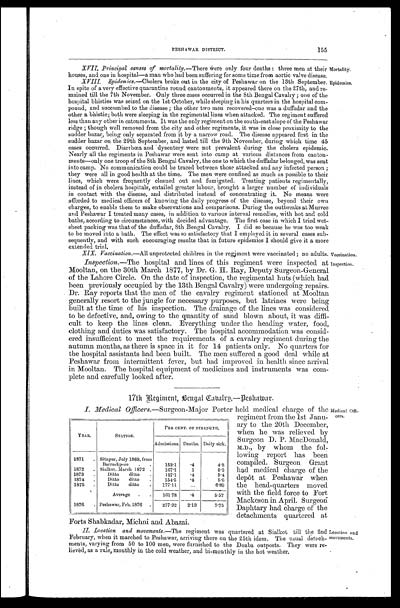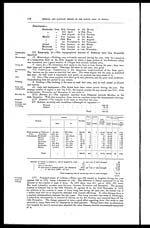Medicine - Institutions > Army health reports and medical documents > Medical and sanitary report of the native army of Bengal > Medical and sanitary report of the native army of Bengal for the year 1876
(185) Page 155
Download files
Individual page:
Thumbnail gallery: Grid view | List view

PESHAWAR DISTRICT.
155
XVII. Principal causes of mortality. —There were only four deaths: three men at their
houses, and one in hospital—a man who had been suffering for some time from aortic valve disease.
Mortality.
XVIII. Epidemics. —Cholera broke out in the city of Peshawar on the 13th September.
In spite of a very effective quarantine round cantonments, it appeared there on the 27th, and re-
mained till the 7th November. Only three cases occurred in the 8th Bengal Cavalry; one of the
hospital bhisties was seized on the 1st October, while sleeping in his quarters in the hospital com-
pound, and succumbed to the disease; the other two men recovered—one was a duffadar and the
other a bhistie; both were sleeping in the regimental lines when attacked. The regiment suffered
less than any other in catonments. It was the only regiment on the south-east slope of the Peshawar
ridge; though well removed from the city and other regiments, it was in close proximity to the
sudder bazar, being only separated from it by a narrow road. The disease appeared first in the
sudder bazar on the 29th September, and lasted till the 9th November, during which time 45
cases occurred. Diarrhœa and dysentery were not prevalent during the cholera epidemic.
Nearly all the regiments in Peshawar were sent into camp at various distances from canton-
ments—only one troop of the 8th Bengal Cavalry, the one to which the duffadar belonged, was sent
into camp. No communication could be traced between those attacked and any infected person;
they were all in good health at the time. The men were confined as much as possible to their
lines, which were frequently cleaned out and fumigated. Treating patients regimentally,
instead of in cholera hospitals, entailed greater labour, brought a larger number of individuals
in contact with the disease, and distributed instead of concentrating it. No means were
afforded to medical officers of knowing the daily progress of the disease, beyond their own
charges, to enable them to make observations and comparisons. During the outbreaks at Murree
and Peshawar I treated many cases, in addition to various internal remedies, with hot and cold
baths, according to circumstances, with decided advantage. The first case in which I tried wet-
sheet packing was that of the duffadar, 8th Bengal Cavalry. I did so because he was too weak
to be moved into a bath. The effect was so satisfactory that I employed it in several cases sub-
sequently, and with such encouraging results that in future epidemics I should give it a more
extended trial.
Epidemics.
XIX. Vaccination. —All unprotected children in the regiment were vaccinated; no adults.
Vaccination.
Inspection. —The hospital and lines of this regiment were inspected at
Mooltan, on the 30th March 1877, by Dr. G. H. Ray, Deputy Surgeon-General
of the Lahore Circle. On the date of inspection, the regimental huts (which had
been previously occupied by the 13th Bengal Cavalry) were undergoing repairs.
Dr. Ray reports that the men of the cavalry regiment stationed at Mooltan
generally resort to the jungle for necessary purposes, but latrines were being
built at the time of his inspection. The drainage of the lines was considered
to be defective, and, owing to the quantity of sand blown about, it was diffi-
cult to keep the lines clean. Everything under the heading water, food,
clothing and duties was satisfactory. The hospital accommodation was consid-
ered insufficient to meet the requirements of a cavalry regiment during the
autumn months, as there is space in it for 14 patients only. No quarters for
the hospital assistants had been built. The men suffered a good deal while at
Peshawar from intermittent fever, but had improved in health since arrival
in Mooltan. The hospital equipment of medicines and instruments was com-
plete and carefully looked after.
Inspection.
17th Regiment, Bengal Cavalry—Peshwar.
| YEAR. | STATION. | PER CENT. OF STRENGTH. | ||
| Admissions. | Deaths. | Daily sick. | ||
| 1871 | Sitapur, July 1869, from Barrackpore |
153.1 | .4 | 4.8 |
| 1872 | Sialkot, March 1872 | 167.1 | 1 | 5.2 |
| 1873 | Ditto ditto | 157.1 | .4 | 5.4 |
| 1874 | Ditto ditto | 154.5 | .4 | 5.6 |
| 1875 | Ditto ditto | 177.11 | 6.89 | |
| Average | 161.78 | .4 | 5.57 | |
| 1876 | Peshawar, Feb. 1876 | 277.92 | 2.19 | 7.75 |
I. Medical Officers. —Surgeon-Major Porter held medical charge of the
regiment from the 1st Janu-
ary to the 20th December,
when he was relieved by
Surgeon D. P. MacDonald,
M.D., by whom the fol-
lowing report has been
compiled. Surgeon Grant
had medical charge of the
depôt at Peshawar when
the head-quarters moved
with the field force to Fort
Mackeson in April. Surgeon
Daphtary had charge of the
detachments quartered at
Forts Shabkadar, Michni and Abazai.
Medical Offi-
cers.
II. Location and movements.— The regiment was quartered at Sialkot till the 2nd
February, when it marched to Peshawar, arriving there on the 25th idem. The usual detach-
ments, varying from 50 to 100 men, were furnished to the Doaba outposts. They were re-
lieved, as a rule, monthly in the cold weather, and bi-monthly in the hot weather.
Location and
movements.
Set display mode to: Large image | Zoom image | Transcription
Images and transcriptions on this page, including medium image downloads, may be used under the Creative Commons Attribution 4.0 International Licence unless otherwise stated. ![]()
| Permanent URL | https://digital.nls.uk/74998584 |
|---|




